by Guest Writer
If you’re in the market to replace your existing deck or want to build a new one, you will want to know what products are available and what your contractor can do with them.
A beautiful deck starts with careful planning and design. The best looking deck often reflects some architectural elements from the house and uses them in the deck. If you have multiple decks on your home consider using matching handrails and decking material for uniformity. Consult with your builder or designer for the many options available today.
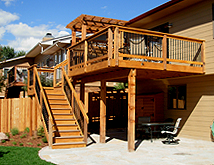 Overall deck costs tend to range from $25-$35 per square foot and cost varies due to height and complexity of construction. The cheapest decking material on the market is probably pressure treated pine the most expensive include exotic hardwood species and top-end coated composite decking. Here is a quick run-down on some of the decking materials available:
Overall deck costs tend to range from $25-$35 per square foot and cost varies due to height and complexity of construction. The cheapest decking material on the market is probably pressure treated pine the most expensive include exotic hardwood species and top-end coated composite decking. Here is a quick run-down on some of the decking materials available:
Decking Materials:
Redwood – soft wood prone to damage from hail, includes the removal of old growth forests that take centuries to recover. Redwood takes hundreds of years to mature and therefore is not a sustainable wood source. Redwood coast around $3-4 per linear foot depending upon the quality ordered.
IPE – Brazilian rainforest lumber that is very dense (hard) and durable. It has a dark color and requires pre-drilling for fasteners. I do not know of any that is sustainably grown / harvested lumber. IPE costs around $4 per linear foot depending on thickness used.
Tigerwood – Brazillian or African rainforest lumber that is very dense (hard) and durable. It has a light dark color variation (tiger striping) and requires pre-drilling for fasteners. I do not know of any that is sustainably grown / harvested lumber. Tigerwood costs around $4 per linear foot depending on thickness used.
Cedar – Soft wood prone to damage from hail, be sure to specify better grades of wood and tight knot or better, can come rough sawn for beams or trimmers and works well for handrails. Tight knot cedar cost around $2 per linear foot and the price almost doubles for clear cedar.
Pressure treated pine: Typically made from southern yellow pine which is pressure treated forcing chemicals into the wood that resist rotting and insect damage. The treatments usually contain copper compounds & other chemicals that are highly corrosive to metals, so extra zinc treatment to galvanized fasteners is recommended to avoid rusting. Older treated wood, produced prior to 2004, often contain arsenic & chromium which can be easily released if burned. It is important to allow the wood to dry out prior to staining or sealing. Pressure treated wood is prone to warping, splitting and twisting and these qualities seem to be exacerbated in dry climates. I believe that staining & sealing these woods can help their look and performance. P.T. pine should be either screwed in place nailed with 16d ring shank nails all fasteners should be hot dipped galvanized.
Composite:
Should you use real wood or composite decking? In the last ten years composite decking materials (plastic/ wood particles glued together) have taken hold of the market and are used on over half the decks being built. Several companies use 90% recycled plastics in their products which will help reduce waste. However, I do not know of any composites that are recyclable when they need replacement. If decking could be continually recycled it would truly be a sustainable product, but no companies, to my knowledge, have produced such a product. All composite decking materials rely on a type of adhesive or glue that bond all of the plastic and wood particles together. These adhesives can be any number of polymers(resin) some which can cause environmental concern if released into the environment especially if burned. The life span of composite decking is similar to a wood deck that is maintained, around 25 years. Eventually all decking materials will end up in a landfill.
There are around ten different companies producing composite deck materials in the U.S. with Trex being one of the first and widely know. These materials include decking and handrail systems and most companies offer different product lines that vary in color and consistency. One California company even offers a bamboo composite BamDeck which uses 30% bamboo and 70% recycled plastic.
The cost of composite decking varies from $2-$4 per linear foot of decking board. Common sizes for composite decking boards are 12’, 16’, 18’ and some 24’ lengths are available from certain manufacturers. Try to design your deck so that no butt joints are required. Composite boards require spacing butt joints from 1/8”-1/4” for board expansion which can be unsightly.
THE GOOD
- Composite decking does not require as much maintenance as natural wood products.
- Does not splinter or split.
- Have built in slip resistance.
- Are consistent in color, shape, and texture.
- Grooved boards can utilize hidden fastener systems which are attractive.
- Boards can be heated and bent into circular patterns.
- Boards are often made with recycled plastic materials up to 90%, which make it more sustainable.
THE BAD
- Boards without a pvc treatment are prone to staining from many different sources. PVC treatments usually cost around $1 more per linear foot of board.
- Material holds heat and can reach temperatures that will burn bare feet in the summer.
- Material is not structural and typically requires a maximum joist spacing of 16 inches, which also limits what can be done with handrails.
- Material shrinks and swells more that wood which requires spacing at butt joints if used.
- Material requires pre-drilling in many circumstances for fasteners.
- Catastrophic failure, rapid deterioration is possible and almost all manufacturers have had to warranty their product for this reason at one time.
- Material is not recyclable.
- Polymers used to glue product together can be harmful if released into the environment, i.e. burning.
People often ask me what is the best composite to use and to be honest I don’t know. The reason for this is that almost all of the companies making composite materials have produced materials that have failed and needed to be replaced.
In 2009 Louisiana Pacific recalled around 48 million linear foot of decking that was sold under three different trade names (WeatherBest®, ABTCo., and Veranda®). Many other companies have had warranty claims for products that are less than five years old. When composite decking fails you will often notice that the color comes off like chalk when you rub it with a finger.
Once composite decking boards start to fail, they can simply start to rot or you may notice flaking, splits, bubbling or other abnormalities. Boards can also break between joists in extreme failures causing injury. Warranties vary from company to company, but in general you can expect a limited 20 year warranty. One thing to note is that the manufacturer’s warranty will only cover material replacement, not labor to remove the old boards and replace them, which can be a substantial cost. Therefore, do your homework and make an informed decision based on a company’s track record.
Some things you should consider if you are planning to use composite decking:
- Texture (slip resistance) especially in frost prone areas.
- Color – try to compliment your homes color. Most composite deck materials fade 30% in the first year and then stabilize. Some even change color so look at samples that have been weathered when possible.
- Cost – almost everyone is on a budget so pick the best material you can afford.
- Warranty – since there have been failures in the past research the company’s products that you are considering and find out their track record and read the fine print on warranties.
- Maintenance – consult manufacturer’s suggestions but most can be cleaned with mild soaps and water.
There are a lot of things to consider when it comes time to build or replace a deck. A new deck can cost as much as a new car so take the time to weigh your options and hire a competent builder. I suggest that you not only talk with a builder’s past client but also take the time to see one of their completed projects.
No decking is completely environmentally friendly or sustainable. In general, many of the natural wood decking products available are from hardwoods or slow growing softwoods which make them less sustainable. Pressure treated southern yellow pine is a faster growing, more sustainable wood product but it utilizes chemicals for rot and insect resistance. If the composite decking industry can develop a product that is recyclable and will consistently perform it will climb to the top of the sustainability chart and my “A” list.
This is a guest post by Bruce Kehr. The owner of Sunlit Builders, LLC, Bruce is one of the top deck builders in Colorado. You can reach Bruce via email at [email protected].
Related Posts:
by Matt Corrion
Ornamental grasses are more popular than ever, and for good reason. They can add texture to the landscape, and they are tough plants that are easy to grow in a variety of conditions. 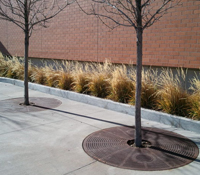 Ornamental grasses can also add beauty to the winter landscape.
Ornamental grasses can also add beauty to the winter landscape.
But should ornamental grasses be cut back to the ground in winter?
Most ornamental grasses develop tall seed heads late in the summer that naturally persist through the winter. When temperatures start to drop the plant will die back, leaving the dried foliage, stalks, and seed heads. The general rule that you should cut back the grasses before the next growing season, so that the new year’s growth will be more vigorous and healthy.
I have found a couple of exceptions to this here in the Denver area, particularly with Mexican Feather Grass (Nassella tenuissima), which did not regenerate as well or look as good the year after I cut it back. I have since started leaving it uncut, which results is the new growth coming up right through the beautiful finely textured golden old growth. But with most varieties, they should be cut back before new growth starts in the spring.
So the question, then, is whether you should cut them back in the fall, or wait until the spring. Many people enjoy the colors and movement that these elements provide in winter. Others prefer a more “neat” or formal look.
I thought it would be interesting to explore the advantages each approach:
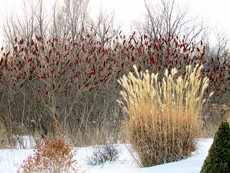
Advantages of leaving the grasses for the winter and waiting until the spring to cut them back
- When shrubs lose their leaves, and perennials wither to the ground, grasses can provide form in the landscape
- Texture: Interesting textures can stand out, collecting frost or snow, and reflecting sunlight
- Movement: Winter winds and soft breezes can move and sway the stems and seed heads of ornamental grasses
- The grasses can add color to the drab winter landscape, including shades of reds, yellows, browns, and blues
- Upright grasses can be used to help screen views when deciduous plants have lost their leaves
- The grasses can provide habitat and shelter for birds and other small animals
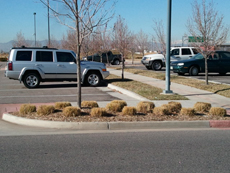
Advantages of cutting back ornamental grasses right away in the fall or early winter
- This can be interesting and different look, I have seen some nice formal plantings that looked stunning with the grasses cut back
- Some grasses hold their form better than others, while some varieties may flop over under heavy snow
- Cutting them back may give the impression (rightly or wrongly) that a commercial landscape is being better maintained
- In some cases the grasses may block sight lines, such as to important signage in a shopping center
- In high foot traffic areas, it may be beneficial to cut back ornamental grasses to avoid them being trampled
So what do you think, is one method better than the other? My personal taste is to leave the grasses up all winter, but there are situations where you may want to cut them back. And you can always decide to cut them back later, if you feel the need to tidy them up.
This is the official blog of Outdoor Design Group, Colorado Landscape Architects. For more information about our business and our services, click here.
Related Posts:
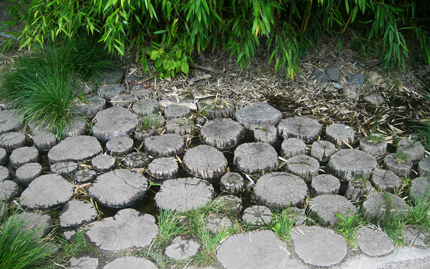
 Overall deck costs tend to range from $25-$35 per square foot and cost varies due to height and complexity of construction. The cheapest decking material on the market is probably pressure treated pine the most expensive include exotic hardwood species and top-end coated composite decking. Here is a quick run-down on some of the decking materials available:
Overall deck costs tend to range from $25-$35 per square foot and cost varies due to height and complexity of construction. The cheapest decking material on the market is probably pressure treated pine the most expensive include exotic hardwood species and top-end coated composite decking. Here is a quick run-down on some of the decking materials available: Ornamental grasses can also add beauty to the winter landscape.
Ornamental grasses can also add beauty to the winter landscape.
